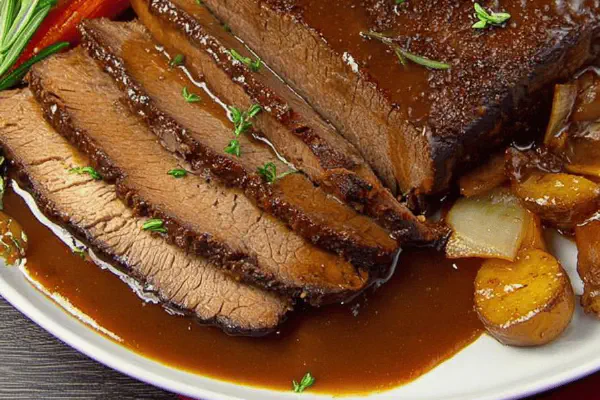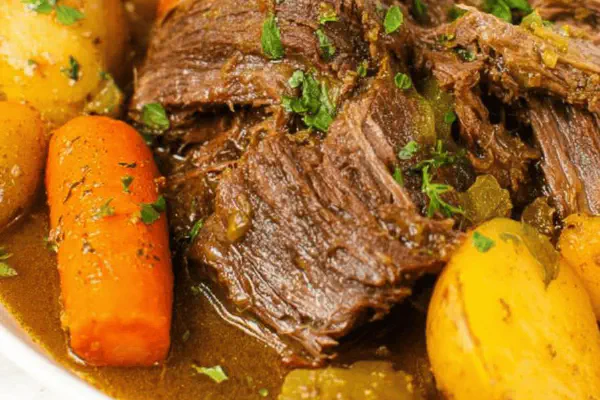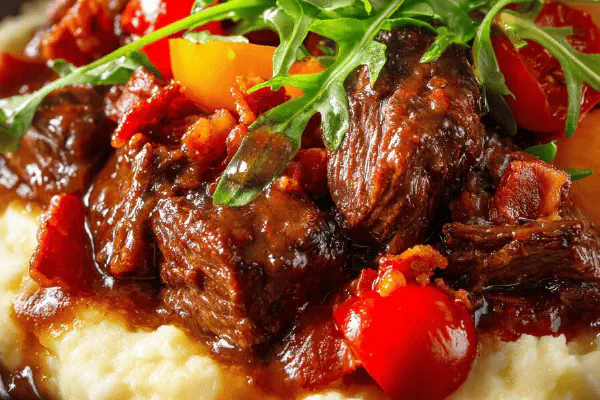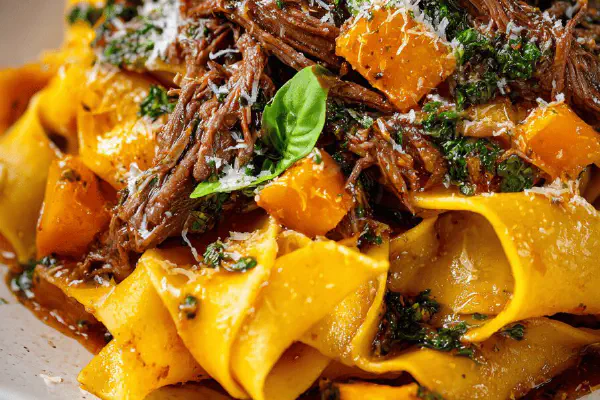Braised Veal Marsala
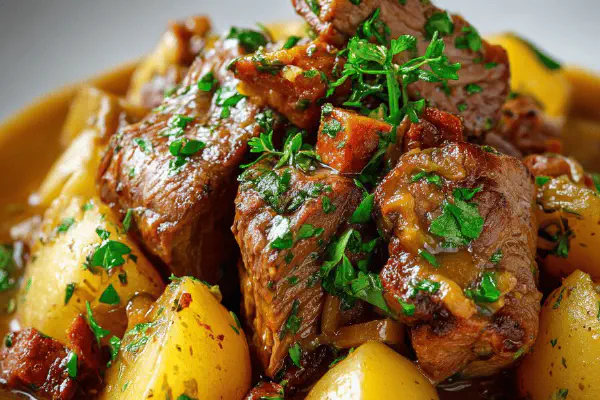
By Emma
Certified Culinary Professional
Ingredients
- 1.45 kg (3.2 lb) veal shoulder with bone reserved
- 45 ml (3 tbsp) olive oil
- 6 ml (1¼ tsp) ground coriander
- 90 g (3.2 oz) spicy smoked sausage diced (such as linguica instead of chorizo)
- 4 shallots peeled, quartered
- 250 ml (1 cup) marsala or dry sherry
- 1 liter (4 cups) chicken stock
- 800 ml (3½ cups) baby Yukon Gold potatoes halved lengthwise
- 60 ml (¼ cup) chopped flat-leaf parsley
- Salt and freshly cracked black pepper
About the ingredients
Method
- Bone out veal shoulder, keep bones for flavor—reduces cooking time, avoids toughness. Trim excess fat, cut meat into large 3 cm cubes.
- Heat 30 ml oil in heavy pot. Brown marrow bones until deeply golden, not burnt. Remove bones, place on plate. Smell nutty, savory.
- Add veal cubes in batches, avoid crowding. Brown all sides to rich chestnut. Add more oil if pan dries. Season with salt, pepper, sprinkle coriander evenly. Browning creates rich fond, key for braise base. Set meat aside.
- Same pot, add sausage cubes; rendered fat will infuse dish. Toss in shallots, stir gently until lightly browned edges, about 4-5 min. Stir constant, avoid blackened bits.
- Deglaze with marsala or dry sherry—swirl pot, scrape bottom for all fond loosened. Avoid sweet marsala; dry/sherry adds complexity and acidity.
- Pour in chicken stock, nestle in veal cubes and bones. Bring to low boil then immediately reduce to very gentle simmer. Cover with lid slightly ajar to control evaporation.
- Simmer just over an hour. Check tenderness visually and by touch. Veal should yield easily to probe, not fall apart. If tough, cook 10-15 min longer; if falling apart, reduce time next attempt.
- Add potatoes, spread evenly. Cook uncovered at medium-low heat about 40 min. Potatoes absorb braise flavors; test doneness by stabbing—should be soft but hold shape.
- Discard bones. Adjust salt and pepper. Toss in chopped parsley off heat to maintain freshness and color, stir.
- Serve with steamed green vegetable to cut richness.
- Optional twist: swap parsley for chopped rosemary and lemon zest for herbal zing next time. Swap Yukon Gold potatoes for fingerlings to vary texture.
- Common mistake: rushing browning leads to pale meat and weak sauce. Pat meat dry beforehand for better sear. Don't stir too aggressively during braise, gently jiggle pot instead.
- If sauce too thin, remove meat and potatoes once done, boil uncovered vigorously to reduce and concentrate.
- With slow cooks, use visual and tactile cues more than strict timing; smell changes from raw to fragrant braise, sauce thickens slightly, and meat texture guide doneness.
Cooking tips
Chef's notes
- 💡 Browning the bones first. Don’t skip even if impatience kicks in. It caramelizes marrow fats, creates deep fond. Pot smells nutty, color shifts to rich gold. Avoid straight tossing bones in pot or sauce layers dull. Separation of marrow and meat browning helps manage heat control. Keep oil just shy of smoking to avoid burnt taste.
- 💡 Batching veal cubes avoids steaming which makes meat pale, rubbery. Must give surfaces space, brown crust builds layer of flavor and smell. Sprinkle coriander right after searing before resting. Uniform cubes size matters; uneven cooks unevenly, some mush, others tough. Pat drying meat before sear pulls moisture, better crust forms; damp meat steams always.
- 💡 Sausage choice flips spice profile. Linguica offers smoky edge unlike typical chorizo; both work but flavor morphs. Render fat gently, low heat by tossing in cubes first, handle shallots carefully. Burnt shallots bitter wreck dish; aim for light browning, stir often but gently—scraping fond while softening aromatics.
- 💡 Deglazing marsala or dry sherry—swirl fast, scrape bottom to lift all fond. Sweet marsala adds dessert-like sweetness, clashing with savory base; use dry type only. Wine must feel astringent with acidity—sharp contrasts simmer out slow and infuse broth. Skipping deglaze leaves dour pan, sauce weak in depth.
- 💡 Adding potatoes midway optimizes texture; starting with big Yukon Gold helps hold shape but fingerlings bring rustic visual and earthy notes. Potatoes soak braise flavor—test doneness by stabbing center; soft but firm to bite. Cooking uncovered thickens sauce naturally, evaporation concentrates richness but watch closely to avoid scorch.
- 💡 Adding parsley off heat. Fresh chopped herb brightens, cuts fatty layers. Skip if earthier, woody rosemary or thyme swaps in but changes vibe. Herbs late stage retains aroma, color intact. Early addition fades or turns bitter with long simmer. Control salt finally after braise done; early salt dries meat and shrinks texture.
- 💡 Simmer heat control crucial. Boil off start then drop to gentle simmer; aggressive boil breaks connective tissue too fast, turns dry or mushy. Lid ajar balances moisture and reduction. No stirring once braise started; breaks meat fibers and suspends sauce thickening. Gentle pot jiggling redistributes heat evenly without damage.
- 💡 If sauce seems thin, remove meat and potatoes then crank heat uncovered, stir often to reduce. Concentration sharpens flavors. Don’t wait too long or sauce waters out on cooling. Keep extra stock prepped to top off if liquid dips low during braise. Balance water loss with fluid additions but keep low boil to maintain texture.
Common questions
How to know veal is done without a timer?
Visual dripping color, fork pokes easily with resistance but not mushy. Smell fragrant braise strong, sauce thickens slightly. Texture cues better than clock; check every 10 min once hour passed. Avoid fall apart meat unless intentional for stew, here want morsels intact.
What if no marsala or sherry on hand?
Substitute dry vermouth, dry white wine works but flavor mild. Avoid sweet wines, overpowering acidity or sugary notes wreck balance. Fortified wines best for sharp, complex aroma. If totally dry variant replace with quality stock plus splash vinegar but careful with acidity spike.
Potatoes falling apart?
Use firmer types like Yukon Gold or fingerlings. Test early by stabbing tip; soft outer layer but hold shape. Overcooked potatoes drown dish texture, turn mushy mess. Add late-stage in braise, uncovered for about 40 min only. For mush lovers adjust time but flavor profile shifts noticeably.
How store leftovers properly?
Cool quickly to room temp, airtight container fridge up to 3 days. Meat firms up, flavor melds overnight. Reheat gently on stove low or microwave short bursts to avoid drying meat. Freeze okay but risk texture change, best consumed fresh. Broth thickens chilled so whisk before warming.
